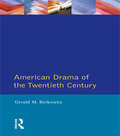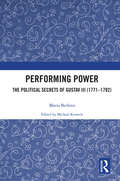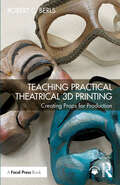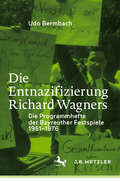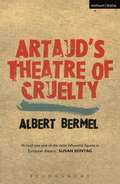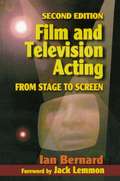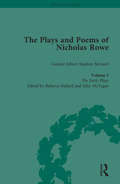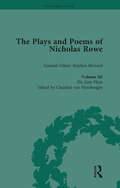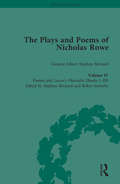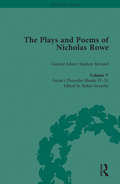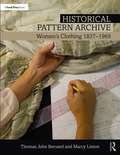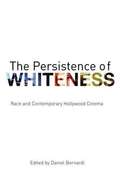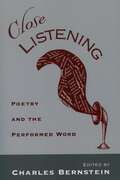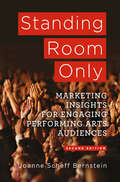- Table View
- List View
American Drama of the Twentieth Century
by Gerald M. BerkowitzIn this book Professor Berkowitz studies the diversity of American drama from the stylistic, experimental plays of O'Neill, through verse, tragedy and community theatre, to the theatre of the 1990s. The discussions range through dramatists, plays, genres and themes, with full supporting appendix material. It also examines major dramatists such as Eugene O'Neill, Arthur Miller, Sam Shephard, Tennessee Williams and August Wilson and covers not only the Broadway scene but also off Broadway movements and fringe theatres and such subjects as women's and African-American drama.
American Drama of the Twentieth Century
by Gerald M. BerkowitzIn this book Professor Berkowitz studies the diversity of American drama from the stylistic, experimental plays of O'Neill, through verse, tragedy and community theatre, to the theatre of the 1990s. The discussions range through dramatists, plays, genres and themes, with full supporting appendix material. It also examines major dramatists such as Eugene O'Neill, Arthur Miller, Sam Shephard, Tennessee Williams and August Wilson and covers not only the Broadway scene but also off Broadway movements and fringe theatres and such subjects as women's and African-American drama.
Yiddish Theatre: New Approaches (The Littman Library of Jewish Civilization)
by Joel BerkowitzThis volume of essays is the first collection of scholarly studies on the Yiddish theatre to appear in English. Drawing on a variety of academic disciplines, it considers the dramatic and musical repertoire of Yiddish theatre and their historical development, popular and critical reception of productions, and the practice and consequences of state censorship. The time-span covered is broad—from the Middle Ages to the twentieth century—as is the geographical range: Cracow, London, Moscow, New York, St Petersburg, Vienna, and Warsaw. Yiddish Theatre not only presents a comprehensive study of the field but also helps illustrate the significance of the Yiddish theatre as a vital form of expression in the Jewish world. Yiddish drama and theatre has had an enormous capacity to entertain audiences on six continents, while at the same time highlighting social, political, religious, and economic concerns of vital interest to the Jewish people. Yiddish Theatre is a valuable resource for scholars, university students, and general readers interested both in Yiddish theatre specifically and related fields such as Jewish literature and culture, east European history and culture, and European and American theatre. The book contains the most comprehensive bibliography to date of sources relating to the Yiddish theatre.CONTRIBUTORS: Ahuva Belkin, Joel Berkowitz Paola Bertolone, Miroslawa M. Bulat, Brigitte Dalinger, Barbara Henry, John Klier, David Mazower, Leonard Prager, Nahma Sandrow, Nina Warnke, Seth L. Wolitz.
Performing Power: The Political Secrets of Gustav III (1771-1792)
by Maria BerlovaPerforming Power explores 18th-century fabrication of the royal image by focusing on the example of King Gustav III (1746–1792) – one of Sweden’s most acclaimed and controversial monarchs – who conspicuously chose theater as the primary media for his image-making and role construction. The text postulates that Gustav III was motivated by theater’s ability to aid him in fulfilling Enlightenment’s tenet of broadly educating the populace and inculcating it with royal ideology. That he was an amateur actor, stage director, and playwright were other engines driving his choice. The project challenges and expands the commonly accepted perception of Gustav III’s contribution to Swedish theater, which has generally been limited to founding its National Opera, developing its national drama, and forming its national dramatic repertoire. Maria Berlova presents Gustav III as a performing King who strategically used political events as a framework through which he could embody the image of the ideal or enlightened monarch as presented by Voltaire. Through this, Performing Power explores the tight relationship and complex bond between theatrical arts and politics. This unique study will be of great interest to students and scholars in theater studies, 18th-century culture, and politics.
Performing Power: The Political Secrets of Gustav III (1771-1792)
by Maria BerlovaPerforming Power explores 18th-century fabrication of the royal image by focusing on the example of King Gustav III (1746–1792) – one of Sweden’s most acclaimed and controversial monarchs – who conspicuously chose theater as the primary media for his image-making and role construction. The text postulates that Gustav III was motivated by theater’s ability to aid him in fulfilling Enlightenment’s tenet of broadly educating the populace and inculcating it with royal ideology. That he was an amateur actor, stage director, and playwright were other engines driving his choice. The project challenges and expands the commonly accepted perception of Gustav III’s contribution to Swedish theater, which has generally been limited to founding its National Opera, developing its national drama, and forming its national dramatic repertoire. Maria Berlova presents Gustav III as a performing King who strategically used political events as a framework through which he could embody the image of the ideal or enlightened monarch as presented by Voltaire. Through this, Performing Power explores the tight relationship and complex bond between theatrical arts and politics. This unique study will be of great interest to students and scholars in theater studies, 18th-century culture, and politics.
Teaching Practical Theatrical 3D Printing: Creating Props for Production
by Robert C. BerlsTeaching Practical Theatrical 3D Printing: Creating Props for Production is a cohesive and practical guide for instructors teaching 3D printing techniques in stagecraft, costume and props courses.Written for the instructor, this book uses non-technical language to explain 3D printers, their workflows and products. Coverage includes the ins and outs of multiple filaments, pros and cons of different types of printers, shop or laboratory setup and safety concerns. The book features lesson plans, rubrics and class-tested sample student projects from design to finished product that highlight learning objectives and methodologies, as well as software and hardware usage explanations and common problems that can occur within design and printing. Step-by-step instructions are included for many types of projects, including fake noses, candlestick phones, buttons, 3D scans, historical recreations and linear actuators. The book also contains examples of poor, average and excellent work with grading explanations and guidance on how to help the student move to the next level with their projects. Chapter objectives, chapter summaries, checklists and reflection points facilitate an instructor in gaining confidence with 3D printers and incorporating their use in the classroom.Teaching Practical Theatrical 3D Printing is an excellent resource for instructors of Props and Costume Design and Construction courses that are interested in using state of the art tools and technology for theatre production.Fully editable files for every object featured in the book are available at www.routledge.com/9781032453279, allowing readers to jump-start their projects and giving them the flexibility to change and redesign the items to best fit their needs.
Teaching Practical Theatrical 3D Printing: Creating Props for Production
by Robert C. BerlsTeaching Practical Theatrical 3D Printing: Creating Props for Production is a cohesive and practical guide for instructors teaching 3D printing techniques in stagecraft, costume and props courses.Written for the instructor, this book uses non-technical language to explain 3D printers, their workflows and products. Coverage includes the ins and outs of multiple filaments, pros and cons of different types of printers, shop or laboratory setup and safety concerns. The book features lesson plans, rubrics and class-tested sample student projects from design to finished product that highlight learning objectives and methodologies, as well as software and hardware usage explanations and common problems that can occur within design and printing. Step-by-step instructions are included for many types of projects, including fake noses, candlestick phones, buttons, 3D scans, historical recreations and linear actuators. The book also contains examples of poor, average and excellent work with grading explanations and guidance on how to help the student move to the next level with their projects. Chapter objectives, chapter summaries, checklists and reflection points facilitate an instructor in gaining confidence with 3D printers and incorporating their use in the classroom.Teaching Practical Theatrical 3D Printing is an excellent resource for instructors of Props and Costume Design and Construction courses that are interested in using state of the art tools and technology for theatre production.Fully editable files for every object featured in the book are available at www.routledge.com/9781032453279, allowing readers to jump-start their projects and giving them the flexibility to change and redesign the items to best fit their needs.
Die Entnazifizierung Richard Wagners: Die Programmhefte der Bayreuther Festspiele 1951-1976
by Udo BermbachDie Bayreuther Festspiele, während des Dritten Reiches „Hitlers Hoftheater“ (Th. Mann), schienen nach dem Zweiten Weltkrieg am Ende und Wagner selbst unheilbar beschädigt. Als 1951 die Bayreuther Festspiele von den Wagner-Enkeln Wieland und Wolfgang doch wiedereröffnet wurden, war dies nur möglich durch einen radikalen ästhetischen wie weltanschaulichen Bruch mit der Vergangenheit. Auf der Bühne wie in den Programmheften der Festspiele vollzog sich der Wandel zu einem neuen Wagner-Verständnis. Anfangs schrieben die alten NS-Autoren auf Wielands Einladung weiter, allerdings mit neuen Themen, und nur allmählich kamen neue Autoren wie Ernst Bloch, Hans Mayer und Theodor W. Adorno hinzu, die das überkommene, völkisch-nationalistische Wagnerbild durch ein modernes ersetzten: Wagner wurde zum Zeitgenossen, der die kapitalistische Gegenwart in starken Texten und Bildern kritisierte. Der Chéreau-Ring von 1976 markierte den Kulminationspunkt dieser Entwicklung. In seinem neuen Wagner-Buch liest Udo Bermbach die Programmhefte der Bayreuther Festspiele auch als Spiegel des intellektuellen Klimas der jungen Bundesrepublik.
Artaud's Theatre Of Cruelty (Plays and Playwrights)
by Albert BermelThe definitive guide to the life and work of Antonin ArtaudAntonin Artaud's theatre of cruelty is one of the most vital forces in world theatre, yet the concept is one of the most frequently misunderstood. In this incisive study, Albert Bermel looks closely at Artaud's work as a playwright, director, actor, designer, producer and critic, and provides a fresh insight into his ideas, innovations and, above all, his writings.Tracing the theatre of cruelty's origins in earlier dramatic conventions, tribal rituals of cleansing, transfiguration and exaltation, and in related arts such as film and dance, Bermel examines each of Artaud's six plays for form and meaning, as well as surveying the application of Artaud's theories and techniques to the international theatre of recent years.
Artaud's Theatre Of Cruelty (Plays and Playwrights)
by Albert BermelThe definitive guide to the life and work of Antonin ArtaudAntonin Artaud's theatre of cruelty is one of the most vital forces in world theatre, yet the concept is one of the most frequently misunderstood. In this incisive study, Albert Bermel looks closely at Artaud's work as a playwright, director, actor, designer, producer and critic, and provides a fresh insight into his ideas, innovations and, above all, his writings.Tracing the theatre of cruelty's origins in earlier dramatic conventions, tribal rituals of cleansing, transfiguration and exaltation, and in related arts such as film and dance, Bermel examines each of Artaud's six plays for form and meaning, as well as surveying the application of Artaud's theories and techniques to the international theatre of recent years.
Film and Television Acting: From stage to screen
by Ian BernardFilm and Television Acting offers solid techniques for creating a natural, believable performance for film and television. The reader will discover techniques for listening and reacting, blocking and business, character, focus, the closeup, and comedy as they pertain to acting in front of a camera. The book analyzes the differences between theatre, film, and television acting, providing the theatre trained actor with specific approaches for making the transition to on-camera work. This second edition is thoroughly revised and updated. The book contains numerous scenes and exercises, including sample scenes from Cheers and Seinfeld, which provide the reader with ways to practice the specific techniques outlined by the author. Included are interviews with well-know actors and directors: Don Murray, Norman Jewison, and Emmy award winner, Glenn Jordan, to name a few. These interviews illustrate how the professionals apply their training and technique to filmed performances. There is also a chapter-length interview with John Lithgow, in which the actor provides a first-hand account of the differences of acting for the theatre and for the camera.
Film and Television Acting: From stage to screen
by Ian BernardFilm and Television Acting offers solid techniques for creating a natural, believable performance for film and television. The reader will discover techniques for listening and reacting, blocking and business, character, focus, the closeup, and comedy as they pertain to acting in front of a camera. The book analyzes the differences between theatre, film, and television acting, providing the theatre trained actor with specific approaches for making the transition to on-camera work. This second edition is thoroughly revised and updated. The book contains numerous scenes and exercises, including sample scenes from Cheers and Seinfeld, which provide the reader with ways to practice the specific techniques outlined by the author. Included are interviews with well-know actors and directors: Don Murray, Norman Jewison, and Emmy award winner, Glenn Jordan, to name a few. These interviews illustrate how the professionals apply their training and technique to filmed performances. There is also a chapter-length interview with John Lithgow, in which the actor provides a first-hand account of the differences of acting for the theatre and for the camera.
The Plays and Poems of Nicholas Rowe, Volume I: The Early Plays (The Pickering Masters)
by Stephen Bernard Rebecca Bullard John McTagueNicholas Rowe was the first Poet Laureate of the Georgian era. A fascinating and important yet largely overlooked figure in eighteenth-century literature, he is the ‘lost Augustan’. His plays are important both for the way they address the political and social concerns of the day and for reflecting a period in which the theatre was in crisis. This edition sets out to demonstrate Rowe’s mastery of the early eighteenth century theatre, especially his providing significant roles for women, and examines the political and historical stances of his plays. It also highlights his work as a translator, which was both innovative and deeply in tune with current practices as exemplified by John Dryden and Alexander Pope. This is the first scholarly edition of all Rowe’s plays and poems and is accompanied by 15 musical scores and 31 black and white illustrations. In this first volume, a general introduction by Stephen Bernard and Michael Caines introduces Rowe's works and the five volumes that comprise this set. It then presents the early plays, The Ambitious Step-Mother, Tamerlane, and The Fair Penitent along with a newly written explanatory introduction by Rebecca Bullard and John McTague which precedes the full edited text. Appendices covering dedications performance history, the related music and textual apparatus are also included. A consolidated bibliography is included with the final volume for ease of reference.
The Plays and Poems of Nicholas Rowe, Volume I: The Early Plays (The Pickering Masters)
by Stephen Bernard Rebecca Bullard John McTagueNicholas Rowe was the first Poet Laureate of the Georgian era. A fascinating and important yet largely overlooked figure in eighteenth-century literature, he is the ‘lost Augustan’. His plays are important both for the way they address the political and social concerns of the day and for reflecting a period in which the theatre was in crisis. This edition sets out to demonstrate Rowe’s mastery of the early eighteenth century theatre, especially his providing significant roles for women, and examines the political and historical stances of his plays. It also highlights his work as a translator, which was both innovative and deeply in tune with current practices as exemplified by John Dryden and Alexander Pope. This is the first scholarly edition of all Rowe’s plays and poems and is accompanied by 15 musical scores and 31 black and white illustrations. In this first volume, a general introduction by Stephen Bernard and Michael Caines introduces Rowe's works and the five volumes that comprise this set. It then presents the early plays, The Ambitious Step-Mother, Tamerlane, and The Fair Penitent along with a newly written explanatory introduction by Rebecca Bullard and John McTague which precedes the full edited text. Appendices covering dedications performance history, the related music and textual apparatus are also included. A consolidated bibliography is included with the final volume for ease of reference.
The Plays and Poems of Nicholas Rowe, Volume III: The Late Plays (The Pickering Masters)
by Stephen Bernard Claudine Van HensbergenNicholas Rowe was the first Poet Laureate of the Georgian era. A fascinating and important yet largely overlooked figure in eighteenth-century literature, he is the ‘lost Augustan’. His plays are important both for the way they address the political and social concerns of the day and for reflecting a period in which the theatre was in crisis. This edition sets out to demonstrate Rowe’s mastery of the early eighteenth century theatre, especially his providing significant roles for women, and examines the political and historical stances of his plays. It also highlights his work as a translator, which was both innovative and deeply in tune with current practices as exemplified by John Dryden and Alexander Pope. This is the first scholarly edition of all Rowe’s plays and poems and is accompanied by 15 musical scores and 31 black and white illustrations. In this third volume the late plays, The Tragedy of Jane Shore and The Tragedy of the Lady Jane Grey are presented, along with a newly written explanatory introduction by Claudine van Hensbergen which precedes the full edited text. Appendices covering performance history, the related music and textual apparatus are also included. A consolidated bibliography is included with the final volume for ease of reference.
The Plays and Poems of Nicholas Rowe, Volume III: The Late Plays (The Pickering Masters)
by Stephen Bernard Claudine Van HensbergenNicholas Rowe was the first Poet Laureate of the Georgian era. A fascinating and important yet largely overlooked figure in eighteenth-century literature, he is the ‘lost Augustan’. His plays are important both for the way they address the political and social concerns of the day and for reflecting a period in which the theatre was in crisis. This edition sets out to demonstrate Rowe’s mastery of the early eighteenth century theatre, especially his providing significant roles for women, and examines the political and historical stances of his plays. It also highlights his work as a translator, which was both innovative and deeply in tune with current practices as exemplified by John Dryden and Alexander Pope. This is the first scholarly edition of all Rowe’s plays and poems and is accompanied by 15 musical scores and 31 black and white illustrations. In this third volume the late plays, The Tragedy of Jane Shore and The Tragedy of the Lady Jane Grey are presented, along with a newly written explanatory introduction by Claudine van Hensbergen which precedes the full edited text. Appendices covering performance history, the related music and textual apparatus are also included. A consolidated bibliography is included with the final volume for ease of reference.
The Plays and Poems of Nicholas Rowe, Volume IV: Poems and Lucan’s Pharsalia (Books I-III) (The Pickering Masters)
by Stephen Bernard Robin SowerbyNicholas Rowe was the first Poet Laureate of the Georgian era. A fascinating and important yet largely overlooked figure in eighteenth-century literature, he is the ‘lost Augustan’. His plays are important both for the way they address the political and social concerns of the day and for reflecting a period in which the theatre was in crisis. This edition sets out to demonstrate Rowe’s mastery of the early eighteenth century theatre, especially his providing significant roles for women, and examines the political and historical stances of his plays. It also highlights his work as a translator, which was both innovative and deeply in tune with current practices as exemplified by John Dryden and Alexander Pope. This is the first scholarly edition of all Rowe’s plays and poems and is accompanied by 15 musical scores and 31 black and white illustrations. In this fourth volume his poetry and the first part of his translation of Lucan's Pharsalia, described by Samuel Johnson as one of the greatest productions in English poetry, is presented. A newly written explanatory introduction by Stephen Bernard to the poems, and by Robin Sowerby to the Pharsalia, precedes each of full edited texts. The second part of the text and textual apparatus are included with the fifth volume of this edition. A consolidated bibliography is also included with the final volume for ease of reference.
The Plays and Poems of Nicholas Rowe, Volume IV: Poems and Lucan’s Pharsalia (Books I-III) (The Pickering Masters)
by Stephen Bernard Robin SowerbyNicholas Rowe was the first Poet Laureate of the Georgian era. A fascinating and important yet largely overlooked figure in eighteenth-century literature, he is the ‘lost Augustan’. His plays are important both for the way they address the political and social concerns of the day and for reflecting a period in which the theatre was in crisis. This edition sets out to demonstrate Rowe’s mastery of the early eighteenth century theatre, especially his providing significant roles for women, and examines the political and historical stances of his plays. It also highlights his work as a translator, which was both innovative and deeply in tune with current practices as exemplified by John Dryden and Alexander Pope. This is the first scholarly edition of all Rowe’s plays and poems and is accompanied by 15 musical scores and 31 black and white illustrations. In this fourth volume his poetry and the first part of his translation of Lucan's Pharsalia, described by Samuel Johnson as one of the greatest productions in English poetry, is presented. A newly written explanatory introduction by Stephen Bernard to the poems, and by Robin Sowerby to the Pharsalia, precedes each of full edited texts. The second part of the text and textual apparatus are included with the fifth volume of this edition. A consolidated bibliography is also included with the final volume for ease of reference.
The Plays and Poems of Nicholas Rowe, Volume V: Lucan’s Pharsalia (Books IV-X) (The Pickering Masters)
by Stephen Bernard Robin SowerbyNicholas Rowe was the first Poet Laureate of the Georgian era. A fascinating and important yet largely overlooked figure in eighteenth-century literature, he is the ‘lost Augustan’. His plays are important both for the way they address the political and social concerns of the day and for reflecting a period in which the theatre was in crisis. This edition sets out to demonstrate Rowe’s mastery of the early eighteenth century theatre, especially his providing significant roles for women, and examines the political and historical stances of his plays. It also highlights his work as a translator, which was both innovative and deeply in tune with current practices as exemplified by John Dryden and Alexander Pope. This is the first scholarly edition of all Rowe’s plays and poems and is accompanied by 15 musical scores and 31 black and white illustrations. In this final volume the second part of his translation of Lucan’s Pharsalia, described by Samuel Johnson as one of the greatest productions in English poetry, is presented along with some his own original poetry. A newly written explanatory introduction to the Pharsalia by Stephen Bernard precedes the full edited text in volume IV. Appendices covering the related music and textual apparatus are also included. The edition comes with a consolidated bibliography for ease of reference.
Historical Pattern Archive: Women’s Clothing 1837-1969
by Thomas John Bernard Marcy LintonHistorical Pattern Archive: Women’s Clothing 1837–1969 is the first book of its kind to capture such a wide range of women’s period patterns in one book, featuring 83 patterns spanning over a century of clothing. The book offers an accurate pattern of each garment on a 1/8" graph that can be used to scale the pattern up to its original size, drawings of each piece from multiple angles, and instructions about how the original garment was constructed and what materials were used. Capturing research and information about garments that would have otherwise stayed hidden or disappeared permanently due to age, wear, or poor storage conditions, this volume is designed to be a tool to preserve history through documenting vintage clothing. Written for historians, reenactors, costumer makers, and costume designers, Historical Pattern Archive will enable readers to study the history behind each piece, implement their original techniques, and recreate unique garments that are both beautiful and historically accurate.
Historical Pattern Archive: Women’s Clothing 1837-1969
by Thomas John Bernard Marcy LintonHistorical Pattern Archive: Women’s Clothing 1837–1969 is the first book of its kind to capture such a wide range of women’s period patterns in one book, featuring 83 patterns spanning over a century of clothing. The book offers an accurate pattern of each garment on a 1/8" graph that can be used to scale the pattern up to its original size, drawings of each piece from multiple angles, and instructions about how the original garment was constructed and what materials were used. Capturing research and information about garments that would have otherwise stayed hidden or disappeared permanently due to age, wear, or poor storage conditions, this volume is designed to be a tool to preserve history through documenting vintage clothing. Written for historians, reenactors, costumer makers, and costume designers, Historical Pattern Archive will enable readers to study the history behind each piece, implement their original techniques, and recreate unique garments that are both beautiful and historically accurate.
The Persistence of Whiteness: Race and Contemporary Hollywood Cinema (PDF)
by Daniel BernardiThe Persistence of Whiteness investigates the representation and narration of race in contemporary Hollywood cinema. Ideologies of class, ethnicity, gender, nation and sexuality are central concerns as are the growth of the business of filmmaking. Focusing on representations of Black, Asian, Jewish, Latina/o and Native Americans identities, this collection also shows how whiteness is a fact everywhere in contemporary Hollywood cinema, crossing audiences, authors, genres, studios and styles. Bringing together essays from respected film scholars, the collection covers a wide range of important films, including Guess Who's Coming to Dinner, The Color Purple, Star Wars and The Lord of the Rings. Essays also consider genres from the western to blaxploitation and new black cinema; provocative filmmakers such as Melvin Van Peebles and Steven Spielberg and stars including Whoopi Goldberg and Jennifer Lopez. Daniel Bernardi provides an in-depth introduction, comprehensive bibliography and a helpful glossary of terms, thus providing students with an accessible and topical collection on race and ethnicity in contemporary cinema. The Persistence of Whiteness investigates the representation and narration of race in contemporary Hollywood cinema. Ideologies of class, ethnicity, gender, nation and sexuality are central concerns as are the growth of the business of filmmaking. Focusing on representations of Black, Asian, Jewish, Latina/o and Native Americans identities, this collection also shows how whiteness is a fact everywhere in contemporary Hollywood cinema, crossing audiences, authors, genres, studios and styles. Bringing together essays from respected film scholars, the collection covers a wide range of important films, including Guess Who's Coming to Dinner, The Color Purple, Star Wars and The Lord of the Rings. Essays also consider genres from the western to blaxploitation and new black cinema; provocative filmmakers such as Melvin Van Peebles and Steven Spielberg and stars including Whoopi Goldberg and Jennifer Lopez. Daniel Bernardi provides an in-depth introduction, comprehensive bibliography and a helpful glossary of terms, thus providing students with an accessible and topical collection on race and ethnicity in contemporary cinema. 9780415774123 9780203939741
Close Listening: Poetry and the Performed Word
by Charles BernsteinClose Listening brings together seventeen strikingly original essays, especially written for this volume, on the poetry reading, the sound of poetry, and the visual performance of poetry. While the performance of poetry is as old as poetry itself, critical attention to modern and postmodern poetry performance has been surprisingly slight. This volume, featuring work by critics and poets such as Marjorie Perloff, Susan Stewart, Johanna Drucker, Dennis Tedlock, and Susan Howe, is the first comprehensive introduction to the ways in which twentieth-century poetry has been practiced as a performance art. From the performance styles of individual poets and types of poetry to the relation of sound to meaning, from historical and social approaches to poetry readings to new imaginations of prosody, the entries gathered here investigate a compelling range of topics for anyone interested in poetry. Taken together, these essays encourage new forms of "close listenings"--not only to the printed text of poems but also to tapes, performances, and other expressions of the sounded and visualized word. The time is right for such a volume: with readings, spoken word events, and the Web gaining an increasing audience for poetry, Close Listening opens a number of new avenues for the critical discussion of the sound and performance of poetry.
Close Listening: Poetry and the Performed Word
by Charles BernsteinClose Listening brings together seventeen strikingly original essays, especially written for this volume, on the poetry reading, the sound of poetry, and the visual performance of poetry. While the performance of poetry is as old as poetry itself, critical attention to modern and postmodern poetry performance has been surprisingly slight. This volume, featuring work by critics and poets such as Marjorie Perloff, Susan Stewart, Johanna Drucker, Dennis Tedlock, and Susan Howe, is the first comprehensive introduction to the ways in which twentieth-century poetry has been practiced as a performance art. From the performance styles of individual poets and types of poetry to the relation of sound to meaning, from historical and social approaches to poetry readings to new imaginations of prosody, the entries gathered here investigate a compelling range of topics for anyone interested in poetry. Taken together, these essays encourage new forms of "close listenings"--not only to the printed text of poems but also to tapes, performances, and other expressions of the sounded and visualized word. The time is right for such a volume: with readings, spoken word events, and the Web gaining an increasing audience for poetry, Close Listening opens a number of new avenues for the critical discussion of the sound and performance of poetry.
Standing Room Only: Marketing Insights for Engaging Performing Arts Audiences
by J. BernsteinStanding Room Only combines practical advice for creating a strategic marketing program and maintaining a successful performing arts organization. This revised edition lays out a framework to navigate the digital age, from online ticketing options, to marketing options in social, and mobile media.
